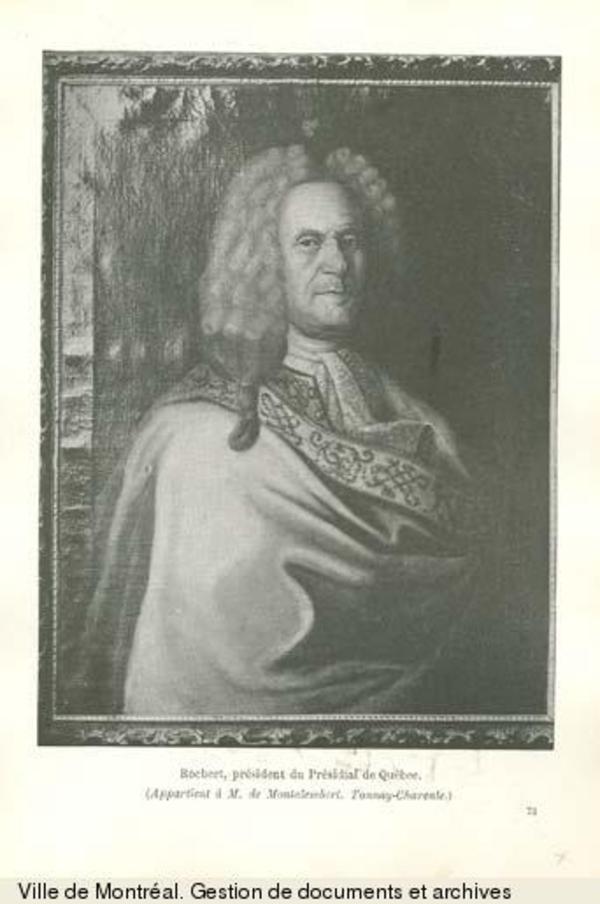
Source: Link
ROCBERT DE LA MORANDIÈRE, ÉTIENNE, king’s storekeeper, subdelegate of the intendant; b. 1668 at Saint-Étienne-d’Étréchy, bishopric of Sens, France, son of Abel Rocbert, notary and lieutenant of the provost court of Étréchy, and Marie Pothier; d. at Rochefort in 1753 or 1754.
Étienne Rocbert de La Morandière began his career as a king’s attorney at Le Havre, but in 1690 he came to New France with his brother Urbain. He was secretary to the commissary of the Marine in Canada, Louis Tantouin* de La Touche, until 1692 when Intendant Champigny [Bochart*] named him king’s storekeeper at Montreal. Although he was destined to remain in that post for 39 years, a bizarre incident in 1705 nearly cut short his career. While strolling with his brother Urbain in the crowded Montreal streets, early in September, he encountered Claude de Ramezay*’s valet on horseback. A quarrel ensued over who should give way, and after insults had led to blows a soldier in Ramezay’s company intervened on the valet’s side. He was killed accidentally by Étienne. Both Rocberts were thrown into jail, where they remained until Governor Rigaud* de Vaudreuil obtained letters of clemency from the king on 17 March 1706. Notwithstanding Vaudreuil’s assistance, however, Étienne supported the intendants Jacques* and Antoine-Denis Raudot* in their bitter disputes with the governor between 1707 and 1711. Jacques Raudot rewarded him in 1709 with a full commission as king’s storekeeper.
Over the next two decades, Étienne built up a handsome private establishment at Montreal. Although he failed in numerous attempts to have his salary increased from 600 livres per year, he did get permission to operate the king’s store side-by-side with his own in the 2,400 square-foot building constructed for him on Rue Saint-Louis in 1700. This arrangement was advantageous in an administrative system that functioned by the long-term accountability of its financial officers more than by day-to-day distinctions between public and private transactions. Unfortunately, it is impossible to determine which of the many creditors mentioned in the notarial records were his own and which were the king’s. Nevertheless he was obviously involved privately in a number of fur-trading ventures and he bought and sold small plots of land at Montreal. One sign of his respected position was his election as a church warden of Notre-Dame parish in 1711. During the 1720s, moreover, he served as syndic of the Recollet fathers.
Marriage alliances also played a big part in enhancing Rocbert’s social standing. On 25 Sept. 1695 he married Élisabeth Duverger, daughter of a Montreal merchant and a relative of the prestigious Saint-Ours family. Several of their six offspring also married into influential Canadian families such as the Petit de Levilliers, Gaultier de Varennes, and Puygibaults. But the most significant marriage alliance was struck à la gaumine in 1718 between Marie-Élisabeth Rocbert and Claude-Michel Bégon, a military officer and brother of Intendant Michel Bégon. Their romance developed during Bégon’s billeting at the Rocbert home in 1712 and continued despite the opposition of the intendant and of the Bégon family in France. In 1737, Marie-Élisabeth’s daughter, Marie-Catherine-Élisabeth, married Honoré Michel de Villebois de La Rouvillière, the commissary of the Marine at Montreal.
This tie proved beneficial to both Étienne and Louis-Joseph Rocbert (b. 6 Aug. 1697); Louis-Joseph had served as a clerk in the Montreal commissariat and in 1731 succeeded his father as king’s storekeeper. Michel periodically employed Étienne throughout the 1730s, adding small bonuses to his pension of 300 livres per year. In 1737 he named him subdelegate of the intendant at Montreal during his own brief tenure as acting intendant at Quebec. At that time, moreover, he and Governor Beauharnois granted Louis-Joseph a large seigneury, called Rocbert, on Lake Champlain. It was reunited to the king’s domain in 1741, but was returned to him on 9 July 1742. Michel also permitted Louis-Joseph to advance huge credits on the king’s account and, when the latter died in 1743, his books showed large deficits. Six years later the Rocbert home was rented to François Bigot* for 1,500 livres per year and Étienne, accompanied by Mme Bégon, went to Rochefort. His son Étienne (b. 22 Feb. 1701) remained in Canada and rose to the rank of captain in the colonial regular troops.
AN, Col., B, 55–85, C11A, 51–85, 113/2; F3, 12. Documents relating to Canadian currency during the French period (Shortt), I, 359. Jug. et délib., V, 465–71. Lettres au cher fils: correspondance d’Élisabeth Bégon avec son gendre (1748–1753), Nicole Deschamps, édit. (Coll. Reconnaissances, Montréal, 1972). Le Jeune, Dictionnaire. A. Roy, Inv. greffes not., XII, 42; XVI, 120, 171–72. P.-G. Roy, Inv. concessions, V, 47–49; Inv. jug. et délib., 1717–1760, IV, 85, 125, 153, 174, 181, 196; V, 45, 110. Frégault, La civilisation de la Nouvelle-France, 158; François Bigot, I, 344–45. P.-G. Roy, La famille Rocbert de La Morandière (Lévis, Qué., 1905); “Les secrétaires des gouverneurs et intendants de la Nouvelle-France,” BRH, XLI (1935), 98.
Donald J. Horton, “ROCBERT DE LA MORANDIÈRE, ÉTIENNE,” in Dictionary of Canadian Biography, vol. 3, University of Toronto/Université Laval, 2003–, accessed November 28, 2024, http://www.biographi.ca/en/bio/rocbert_de_la_morandiere_etienne_3E.html.
The citation above shows the format for footnotes and endnotes according to the Chicago manual of style (16th edition). Information to be used in other citation formats:
| Permalink: | http://www.biographi.ca/en/bio/rocbert_de_la_morandiere_etienne_3E.html |
| Author of Article: | Donald J. Horton |
| Title of Article: | ROCBERT DE LA MORANDIÈRE, ÉTIENNE |
| Publication Name: | Dictionary of Canadian Biography, vol. 3 |
| Publisher: | University of Toronto/Université Laval |
| Year of publication: | 1974 |
| Year of revision: | 1974 |
| Access Date: | November 28, 2024 |